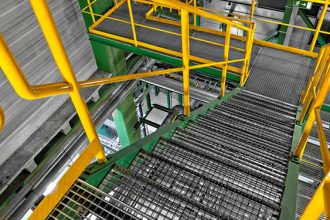Is It Okay To Cut Pallet Rack Uprights?

Sometimes a rack owner will decide to relocate an existing pallet rack structure to a different location within the same facility — only to discover that the new space has a lower ceiling height than the original site. If only the columns were shorter, the racking would fit perfectly into the new space. But, if those uprights are cut down to the desired length, will the system still be safe? Maybe. Maybe not. The best way to find out — before firing up the angle grinder, plasma cutter, or hacksaw — is to consult with a professional rack design engineer.
It’s important to do this because most industrial steel storage rack systems are engineered specifically for a single storage application in a given space. As explained in RMI’s ANSI MH16.1: Specification for the Design, Testing and Utilization of Industrial Steel Storage Racks, the total capacity of the rack frame is determined by the vertical distance between shelf beams (which brace the structure) and the weight of the loads placed on the beams. Shortening the length of the rack columns might impact the number of beams or their spacing and alter the overall capacity of the structure, creating a potentially unsafe situation.
Prior to making any modifications to the racking — including cutting down the uprights — start by reviewing the original equipment manufacturer’s (OEM’s) load application and rack configuration (LARC) drawings. These drawings include details about the maximum safe storage capacity of a given racking structure, any possible alternative configurations, and information about the OEM.
Best practice is to return to the OEM to discuss the proposed modifications with one of their licensed professional rack engineers, and engage them for a review. The engineer will analyze the structure’s drawings to ensure that the system will remain safe after the height of the columns is reduced.
Conversely, if the original LARC drawings are unavailable — or if it is not possible to determine the identity of the manufacturer who originally designed and constructed the rack — an independent, licensed professional engineer can be engaged to review the desired changes. This engineer should analyze the existing structure and its components to create new drawings prior to determining if the modifications are permissible.
Regardless of whether the engineer engaged for the project review is with the rack OEM or an independent consultant, they should also inspect the existing structure thoroughly. This assessment will determine if any components are damaged. If damage is discovered, it should be repaired or replaced under the engineer’s supervision prior to shortening the rack columns.
Thinking of modifying or reconfiguring your current pallet rack? For more information about how to do it safely, visit RMI’s website.


